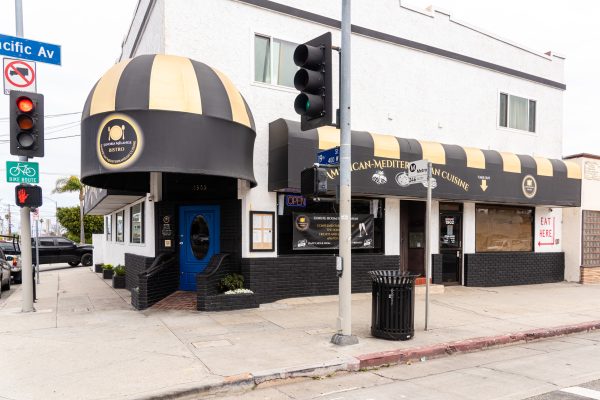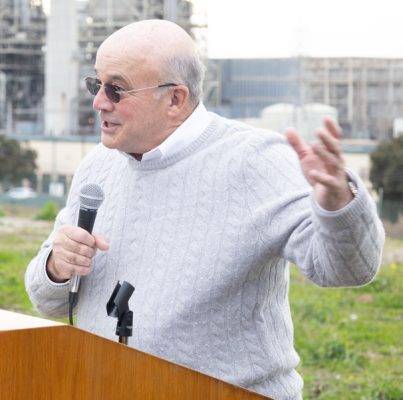
One afternoon last week in a Hermosa Valley School classroom, music teacher Kenny Harrison began class with an exercise based around the solfège sight-singing sounds. (“Do re mi…”). He strummed a progression on his guitar, and sang out ditties of three or four notes, “So fa so,” “so mi so” and so on. The fourth graders were to repeat after Harrison, unless he sang “so la mi,” after which they had to remain silent. In a sign of the hypnotic power of melody, the game quickly came to resemble “Simon Says,” with kids calling out “So la…” then jolting their arms out, as if they were trying to put the sound back in their mouths.
The game was played to five. Students got a point if they managed to keep quiet following a “so la mi,” while Harrison got a point if the class did not. What kept the game interesting, though, was another rule: if a student kept singing, and then another student complained or criticized the one who spoke up, Harrison got two points. Harrison came up with the double-deduction rule after noticing kids bemoan a fellow student’s mistake, and then seeing the offending student shrink with embarrassment.
“You harness the competitive vibe in kids. They get to practice the stuff, but what better way to have kids practice being nice to each other. It’s the kind of thing you can do in other classes, but in music it’s so much easier,” Harrison said.
Harrison is the first full-time music instructor at the Hermosa Beach City School District in almost a decade. He was a constant presence during that gap, including leading the after-school Hermosa Beach Youth Music (HBYM). But with instruction returning to the classroom, Harrison now has the chance to spend up to eight years with a student, something he views as both an opportunity and a responsibility.
“I can learn what makes them tick, what they’re interested in. I think the only other teacher who gets to know them that well is the PE teacher,” Harrison.
Back in class, one student started to wonder if he’d been had. What did the kids get, he wanted to know, if their side won. “My undying respect,” Harrison deadpanned. He was already strumming before the answer made it out of his mouth, and the kids got lost in music before they could bother to care. The students squeaked by, 5-4
Sitting in
Harrison found music when a third-grade teacher gave him a seemingly impossible assignment: compose a song.
He had no musical experience. At the time, Harrison was living in an apartment in West Los Angeles with his mom. His mom knew one of the tenants downstairs was a piano player, and set up a 30 minute lesson for her son.
“The way my mom tells the story, which seems to get more exaggerated every time, is, Three hours later, I come back with a symphony. In reality it wasn’t much at the time, but it was all written out with notes,” Harrison recalled.
Something in the experience clicked for Harrison. His dad bought him a keyboard to practice on, and his mom arranged for weekly lessons, which continued through middle school.
This early experience revealed a fundamental challenge of music education: matching students’ interests with a core set of underlying principles, what might be called “rigor” in education parlance. With music once again part of the official curriculum, district officials say that Harrison and his classes will be evaluated according to the same state standards to which other disciplines are held.
Music fosters a devotion that other academic disciplines struggle to match; head bobbing is hard to find in a history class, let alone shouting and contorting. But like all subjects, music has a set of fundamental skills needed to advance and appreciate its wonders. Push these too hard, and you risk robbing music of its magic. Let them slide, and all you’ve got is noise. The piano player, Harrison said, gave him an early sense of how to strike a balance.
“He would teach me what I needed to know, and then ask me what I wanted to know. He’d say, ‘We’re going to play this Mozart piece. You were interested in jazz. We can talk about reading jazz chords, but you’ve got to know this scale from Mozart if you want to play this blues scale from Thelonious Monk.’ And he totally connected those two things,” Harrison said.
Former students of Harrison say that he has the same ability. Xavier Hogan is a freshman at Mira Costa High School, where he plays in the marching band and the jazz ensemble. He first met Harrison in fourth grade when he joined the after-school HBYM.
At the time, Hogan didn’t see himself playing a wind instrument; he was more interested in the guitar. But he followed Harrison into the trumpet, and later picked up the French horn. Harrison is approachable, and draws students in by showing them how much joy they can find in places they might not have expected.
“He knows when to be serious, and he knows when to be fun. And he’s very charismatic: he can tell you something without being too direct. He’s a real teacher,” Hogan said.
At least part of bridging this gap comes from his understanding of the social side of music. Harrison moved to Hermosa from Los Angeles with his mom in eighth grade. As he prepared to enter Mira Costa High School, he was nervous about not having any friends.
Thankfully, he joined the marching band. The program could be intense, with high demands from then-band director Al Adams. But it also provided him with his first real group of friends in the area, an association that continues to influence his approach.
“I didn’t know anyone from the South Bay. But on the first day of school, I got 12 close friends: that was the trumpet section,” Harrison recalled.
History lesson

This month, students across the district have been learning about Martin Luther King, Jr. and the Civil Rights Movement; in other classes, Harrison had taught the gospel song “This Little Light of Mine.” Fifth graders last week could be heard chanting “Martin Luther King/led a march,” rushing through the five syllables of the first half, while spacing out the last three. Students repeated it four times. Without being prompted, they built in volume each time, as if they were a football team psyching each other up for a big game.
The different meters in the two halves of the phrase segued into a lesson on the difference between beat and rhythm. Harrison picked up the guitar and played a spritely song from Ghana. Students sang the song without understanding a word of the lyrics. (English is the official language of Ghana, but there are more than a dozen recognized national languages, mostly from the Niger-Congo family.) He followed by allowing them to examine a maraca-like instrument he had acquired several years earlier. It was crafted from a gourd, and still had a “Made in Ghana” tag attached to it. Beat established, groups of students got to use the instrument to come up with their own rhythms, and demonstrate them in front of the class.
As the students returned to their seats, Harrison asked the students what else they knew about Ghana. He pulled down a Cram-style map, pointed to the west coast of Africa, and explained that it was the ancestral home of many of the people who would be kidnapped and sold into slavery in the United States.
“It’s not our brightest, proudest moment, but it’s our history, and we should know it,” Harrison told the class.
He then taught them one more song: “Follow the Drinking Gourd,” which sounded as though it had been plucked from the catalogs of John Lomax. The song, Harrison explained, was used by slaves as a way of relating a means of escaping north on the Underground Railroad. (The “drinking gourd” of the title was the Little Dipper, the constellation in which the North Star serves as the tip of the handle.)
In 15 minutes, Harrison had managed to link two eras of black history separated by a century. It is unlikely that he could have accomplished this without music. Indeed, even before Harrison explained this, students seemed to internalize the solemnity of the minor-key “Drinking Gourd,” repeating the lyrics in much more subdued fashion than they had with the day’s other tunes.
View School principal Sylvia Gluck,said she often collaborates with Harrison to tie other aspects of the curriculum into the music program. This week is “Kindness Week”, and Harrison has been teaching students “Kind-hearted Hand,” a thematic children’s song about kindness that they will perform on Friday.
Last year, Harrison organized a “Hamilton”-influenced, alphabetical ode to Americana. Later this year, students at View will perform a series of songs devoted to the states, built around the idea of a road trip.
Since he began teaching at View last year, Gluck said, Harrison has had a significant impact on the campus. She said that she often hears students singing songs from that week as she passes them in the halls.
“Sometimes if it’s a tough morning, I’ll say to him, ‘I think I’m going to start off in your class,’” Gluck said. “And I think I’m only going to go in for 10 minutes. I end up spending half an hour.”
Long road home
As was the case for many districts throughout the state, music left the curriculum in the HBCSD in 2009 amid recession-induced cutbacks. For most of the time since it left the curriculum, Hermosa students looking for experience in song have found it through Hermosa Beach Youth Music.
The parent-run nonprofit organized band and choral programs after school. Facilities waivers from the district let them use space on the Valley campus. Under Harrison’s leadership, the HBYM band traveled to competitions, and held its own against programs benefiting from in-class, school instruction time.
But despite their devotion to the program, HBYM officers and board members were kind of trying to put themselves out of business. Along with organizing practices and collecting instruments, they advocated before the school board for music to be reintroduced to the classroom.
“We want it to be for everybody. Right now, we’re only getting to a small portion of students,” said Regina Hoffman, a district parent and one of the founders of HBYM, in a 2015 Easy Reader interview.
The group’s presentations to the school board touted music’s many academic benefits, including enhancing memory and improving standardized test scores. The school board was receptive but, even after budgets began to recover, the district faced a space crunch. Hermosa was hundreds of students over capacity, and lacked a place to store instruments and equipment.
But shortly after the passage of school facilities bond Measure S in 2016, intended to relieve overcrowding, the district rolled out a three-year plan to reintroduce music. Weekly instruction began in the 2016-17 school year for grades one through three at View. This year, it expanded to fourth and fifth graders at Valley. Next year, students in grades six through eight will be able to take band as a full elective. HBYM will transition into a “support organization.”
The staggered rollout creates challenges on top of those already present. (“I have 728 students that I see once a week for 35 minutes,” is Harrison’s daunting, minimalist synopsis.) Most of his current fifth graders, for example, have never had in-class musical instruction, while he has already worked with his fourth graders for a year. The benefit, though, is he will eventually have a class he can lead all the way through, and hopefully inspire a deep passion for music.
In the meantime, district parents and the Parent-Teacher Organization have led instrument collection drives. The process is ongoing, with an eye toward helping to equip next year’s band. There is already much to show for their efforts, including two dozen ukuleles and a set of steel drums.
“I’m blown away by community support. I couldn’t be luckier as a teacher,” Harrison said. “And this is what I feel like is really the character of Hermosa: they’re so supportive, but they’re also really patient. They’re not like, ‘Ok, so I got you all these ukuleles, when is my kid going to be playing ukulele songs?’”
The Hermosa Beach Education Foundation continues to help the district defray costs now that music is back in the classroom. HBEF President Carla Persell recently attended the Winter Concert at Valley.
“The room was absolutely packed. It was a way bigger turnout than they expected. The turnout illustrates how excited parents in this community are to have music back,” Persell said.
The ‘Face of the School’
In an annual tradition that began with a request from former school board member Greg Breen, the Hermosa Beach Youth Music band will play the National Anthem and “Take Me Out to the Ballgame” on Opening Day of Hermosa Beach Little League. Playing outside gives the kids a taste of the marching band experience. And for Harrison, it’s an opportunity to cement the connection between student musicians and the community — a connection that he admits will be easier once the band program is integrated into the school.
“With the band, I’ve been trying to make them the face of the school. Soon, they can go to the Tree Lighting, or Opening Day, or the St. Patrick’s Day Parade, and say, This is the Hermosa Valley Band,” Harrison said.
One day last week, as the students in the after-school band tried out new songs, Harrison demonstrated the teacher’s art of being everywhere at once. (Next year, Harrison will be teaching in a music room, instead of the temporary classroom at Valley that now hosts the after-school band). He helped the bassoon player, a new addition for this year, pick out the bass line, then told the student how he was helping lead the clarinet section. He cocked his head at a girl’s out-of-tune alto saxophone, listening like a doctor through a stethoscope. (“Watch what happens when they play at once. See how it sounds like a horror movie?” he told the class.) And as one student struggled to hit an A note on a trumpet, Harrison stressed the importance of practicing at home. The note has the same fingering as the E, but requires tightened stomach muscles, clenched embouchure and more rapid breath — concepts he did not have time to stress in a group setting.
Harrison clearly expected more of the band students, who were more experienced and there by choice, than he did of his third graders. But he knows that not every student in his band intends to make a career of music. His challenge is to meet the needs of everyone, while still allowing those with more fire to burn a bit brighter.
“That’s what keeps you up at night as a teacher: How do you service all of these individuals while still getting to the group?” Harrison said.
Over the years, Harrison has tried countless techniques. At the most recent Halloween Carnival, he found an arrangement of “Thriller” that allowed some students to play on a full drum kit, instead of just a snare. But his real secret appears to be something teachers and musicians share: being good listeners.
Cole Riddle first met Harrison in fourth grade. He began playing the saxophone after school and was, in his description, “not very good.” He switched to percussion, and found his passion. He played the keyboard in 11Echo, which won Easy Reader’s “Best Underage Band” award three years in a row. Today, he is studying piano at UCLA.
Over the summer, Riddle and Harrison went on tour with musician Liv Gibson, opening for ‘80s rockers Huey Lewis and the News. It was a surreal experience for Riddle, who had long looked to Harrison as a mentor, to be playing with him as a peer. But in one sense, Riddle said, Harrison had always taken what his students said seriously.
“What sets Kenny apart is he’s so personable. Your opinion really matters to him. He really accepts all levels of musicality. Whether you’re an expert or a fourth-grader just picking up trombone, he really values what you have to say,” he said.









